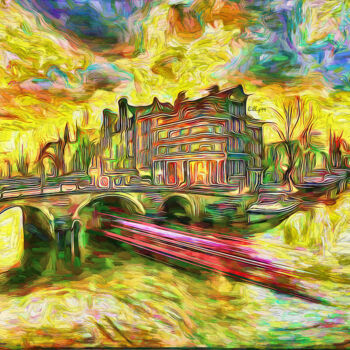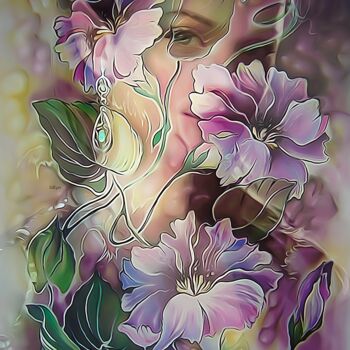"Fine-Arts" Druck auf Papier
Es handelt sich um ein Verfahren zum Drucken auf Kunstdruckpapier mit sehr hochwertigen Pigmenttinten, das in sehr hoher Auflösung gedruckt wird. Der Konservierungsgrad ist aussergewöhnlich (über 100 Jahre), Qualität, Tiefe und Nuancenreichtum übertreffen den klassischen Fotodruck auf Argentic-Papier.

Glänzende Oberfläche
Abgesehen von seiner aussergewöhnlichen Dicke besteht das Faserpapier aus einer säurefreien Alpha-Cellulosebasis, die mit Bariumsulfat bedeckt ist, und einer mikroporösen Schicht, die die Pigmente beim Drucken absorbiert. Dieses Papier hat eine rein weisse Farbe und ist lichtecht. Es wurde speziell für Beständigkeit und Alterung entwickelt. Es wird von grossen Museen weltweit verwendet, da es eine hervorragende Auflösung bietet und tiefe und dichte Farben wiedergibt.
Kunstdruck "Fine Art" - Hochglanzlackierung auf Fasergrundpapier 325 g.

Unsere hochwertigen Drucke und Reproduktionen
ArtMajeur verwendet nur Naturpapiere mit neutralem pH-Wert, beständig und von hoher Qualität, ausgewählt von renommierten Papierherstellern!
Unser Masterdrucker achtet ständig darauf, sei es in Bezug auf die Farbkontrolle oder die Einhaltung der Grafikkette. Unser hoher Qualitätsanspruch ist ein wesentlicher Vorteil der gerahmten Kunstdrucke von ArtMajeur.
Für Künstler! Sie helfen Künstlern, von ihrer Arbeit zu leben. Sie erhalten jedes Mal, wenn Sie ihre Drucke kaufen, Tantiemen.
Über unsere DruckeErwerben Sie eine Lizenz, um dieses Bild für Ihre Website, Ihre Kommunikation oder den Verkauf abgeleiteter Produkte zu verwenden.
Usage: Weblizenz
| 1500 px | ||

|
985 px |
| Abmessungen der Datei (px) | 1500x985 |
| Einsatz weltweit | Ja |
| Verwendung auf Multiträgern | Ja |
| Verwenden Sie auf jeder Art von Medien | Ja |
| Widerrufsrecht | Nein |
| Max. Anzahl der Drucke | 0 (Zero) |
| Produkte zum Verkauf angeboten | Nein |
Sofort nach dem Kauf herunterladen
Dieses Bild steht zum Download mit einer Lizenz zur Verfügung: sie können sie jederzeit herunterladen.
Einschränkungen
Alle Bilder auf ArtMajeur sind von Künstlern geschaffene Original Kunstwerke, alle Rechte sind strengstens vorbehalten. Der Erwerb einer Lizenz gibt das Recht, das Bild unter den Bedingungen der Lizenz zu nutzen oder zu verwerten. Es ist möglich, geringfügige Änderungen vorzunehmen, wie z.B. das Bild neu auszurichten oder zu fokussieren, damit es perfekt zu einem Projekt passt. Es ist jedoch verboten, Änderungen vorzunehmen, die das Originalwerk in seiner Integrität beeinträchtigen könnten (Änderung der Formen, Verzerrungen, Ausschneiden, Änderung der Farben, Hinzufügen von Elementen usw.), es sei denn, es liegt eine schriftliche Genehmigung des Künstlers vor.
Sonderlizenzen
Wenn Ihre Nutzung nicht durch unsere Standard Lizenzen abgedeckt ist, kontaktieren Sie uns bitte für eine benutzerdefinierte Lizenz.
Kunst Bilddatenbank-
Diese Arbeit ist eine "Open Edition"
Digitale Kunst,
Giclée / Digitaldruck
- Masse Verschiedene Grössen erhältlich
- Mehrere Möglichkeiten (Kunstdruckpapier, Drucke auf Metall, Leinwand)
- Rahmen Rahmung zur Verfügung (Schwebender Rahmen verglast, Rahmen mit Acrylglas)
- Kategorien Impressionismus
Amsterdam (/ˈæmstərdæm/, UK also /ˌæmstərˈdæm/;[10][11] Dutch: [ɑmstərˈdɑm] (About this soundlisten)) is the capital and most populous city of the Netherlands with a population of 872,680[12] within the city proper, 1,380,872 in the urban area[5] and 2,410,960 in the metropolitan area.[9] Found within the province of North Holland,[13][14] Amsterdam is colloquially referred to as the "Venice of the North", attributed by the large number of canals which form a UNESCO World Heritage Site.
Amsterdam's name derives from Amstelredamme,[15] indicative of the city's origin around a dam in the river Amstel. Originating as a small fishing village in the late 12th century, Amsterdam became one of the most important ports in the world in the Dutch Golden Age of the 17th century and became the leading centre for finance and trade.[16] In the 19th and 20th centuries, the city expanded, and many new neighbourhoods and suburbs were planned and built. The 17th-century canals of Amsterdam and the 19–20th century Defence Line of Amsterdam are on the UNESCO World Heritage List. Sloten, annexed in 1921 by the municipality of Amsterdam, is the oldest part of the city, dating to the 9th century.
As the commercial capital of the Netherlands and one of the top financial centres in Europe, Amsterdam is considered an alpha-world city by the Globalization and World Cities (GaWC) study group. The city is also the cultural capital of the Netherlands.[17] Many large Dutch institutions have their headquarters there, including Philips, AkzoNobel, TomTom and ING.[18] Also, many of the world's largest companies are based in Amsterdam or have established their European headquarters in the city, such as leading technology companies Uber, Netflix and Tesla.[19] In 2012, Amsterdam was ranked the second best city to live in by the Economist Intelligence Unit (EIU)[20] and 12th globally on quality of living for environment and infrastructure by Mercer.[21] The city was ranked 4th place globally as top tech hub in the Savills Tech Cities 2019 report (2nd in Europe),[22] and 3rd in innovation by Australian innovation agency 2thinknow in their Innovation Cities Index 2009.[23] The Port of Amsterdam is the fifth largest in Europe.[24] Amsterdam Airport Schiphol is the busiest airport in the Netherlands, and the third busiest in Europe. Famous Amsterdam residents include the diarist Anne Frank, artists Rembrandt and Van Gogh, and philosopher Baruch Spinoza.
The Amsterdam Stock Exchange is the oldest stock exchange in the world. Amsterdam's main attractions include its historic canals, the Rijksmuseum, the Van Gogh Museum, the Stedelijk Museum, Hermitage Amsterdam, the Concertgebouw, the Anne Frank House, the Scheepvaartmuseum, the Amsterdam Museum, the Heineken Experience, the Royal Palace of Amsterdam, Natura Artis Magistra, Hortus Botanicus Amsterdam, NEMO, the red-light district and many cannabis coffee shops. They draw more than 5 million international visitors annually.[25] The city is also well known for its nightlife and festival activity; several of its nightclubs (Melkweg, Paradiso) are among the world's most famous. It is also one of the world's most multicultural cities, with at least 177 nationalities represented.[26]







